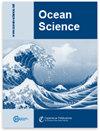热带大西洋东部混合层热盐收支联合观测模式
IF 3.3
3区 地球科学
Q2 METEOROLOGY & ATMOSPHERIC SCIENCES
引用次数: 1
摘要
摘要在这项研究中,我们使用联合观测模型方法研究了热带大西洋东部混合层的年平均和季节收支。与在线的NEMO (Nucleus for European Modelingof Ocean)相比,区域性的PREFCLIM(前言气候学)观测气候学提供的预算项具有相对较低的空间和时间分辨率。Madec, G., 2014)模型,然后像在PREFCLIM气候学中那样重新采样。此外,从模型中离线重新计算平流项作为PREFCLIM网格平流计算。在塞内加尔、安哥拉和本格拉地区,混合层温度的季节周期主要受地表热通量的支配;然而,它本质上是由赤道地区的垂直热扩散驱动的。塞内加尔和本格拉地区混合层盐度的季节循环主要受淡水通量控制;然而,它遵循赤道和安哥拉地区纬向和经向盐平流的变率。结果表明,NEMO离线热盐平流项的时间平均空间分布优于PREFCLIM水平平流项,而不是在线热盐平流项。然而,选定地区水平平流的季节周期表明,NEMO离线项并不总是与prefclim相比较,有时不如在线项。尽管存在这种差异,但这些结果表明,小尺度变化在混合层热盐收支中发挥了重要作用。本文章由计算机程序翻译,如有差异,请以英文原文为准。
Joint observation–model mixed-layer heat and salt budgets in the eastern tropical Atlantic
Abstract. In this study, we use a joint observation–model approach
to investigate the mixed-layer heat and salt annual mean as well as seasonal
budgets in the eastern tropical Atlantic. The regional PREFCLIM (PREFACE Climatology)
observational climatology provides the budget terms with a relatively low
spatial and temporal resolution compared to the online NEMO (Nucleus for European Modeling
of the Ocean; Madec, G., 2014) model, and this
is later resampled as in PREFCLIM climatology. In addition, advection
terms are recomputed offline from the model as PREFCLIM gridded advection
computation. In the Senegal, Angola, and Benguela regions, the seasonal cycle of
mixed-layer temperature is mainly governed by surface heat fluxes; however,
it is essentially driven by vertical heat diffusion in the equatorial region.
The seasonal cycle of mixed-layer salinity is largely controlled by
freshwater flux in the Senegal and Benguela regions; however, it follows the
variability of zonal and meridional salt advection in the equatorial and Angola
regions, respectively. Our results show that the time-averaged spatial
distribution of NEMO offline heat and salt advection terms compares much better
to PREFCLIM horizontal advection terms than the online heat and salt advection
terms. However, the seasonal cycle of horizontal advection in selected
regions shows that NEMO offline terms do not always compare well with
PREFCLIM, sometimes less than online terms. Despite this difference, these
results suggest the important role of small-scale variability in mixed-layer
heat and salt budgets.
求助全文
通过发布文献求助,成功后即可免费获取论文全文。
去求助
来源期刊

Ocean Science
地学-海洋学
CiteScore
5.90
自引率
6.20%
发文量
78
审稿时长
6-12 weeks
期刊介绍:
Ocean Science (OS) is a not-for-profit international open-access scientific journal dedicated to the publication and discussion of research articles, short communications, and review papers on all aspects of ocean science: experimental, theoretical, and laboratory. The primary objective is to publish a very high-quality scientific journal with free Internet-based access for researchers and other interested people throughout the world.
Electronic submission of articles is used to keep publication costs to a minimum. The costs will be covered by a moderate per-page charge paid by the authors. The peer-review process also makes use of the Internet. It includes an 8-week online discussion period with the original submitted manuscript and all comments. If accepted, the final revised paper will be published online.
Ocean Science covers the following fields: ocean physics (i.e. ocean structure, circulation, tides, and internal waves); ocean chemistry; biological oceanography; air–sea interactions; ocean models – physical, chemical, biological, and biochemical; coastal and shelf edge processes; paleooceanography.
 求助内容:
求助内容: 应助结果提醒方式:
应助结果提醒方式:


